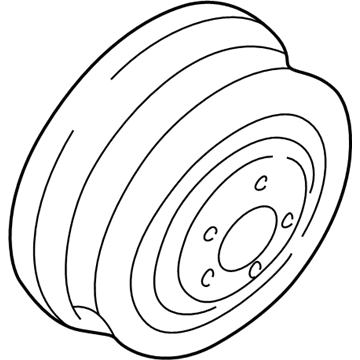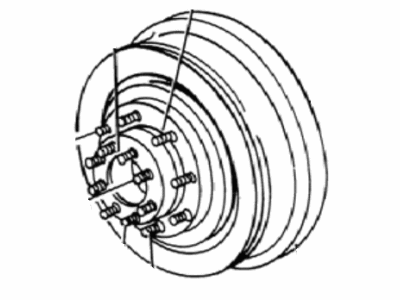
My Garage
My Account
Cart
Genuine Dodge Ramcharger Brake Drum
- Select Vehicle by Model
- Select Vehicle by VIN
Select Vehicle by Model
orMake
Model
Year
Select Vehicle by VIN
For the most accurate results, select vehicle by your VIN (Vehicle Identification Number).
4 Brake Drums found
Dodge Ramcharger Brake Drum
Brake Drum of Dodge Ramcharger cars is an important part of a vehicles' braking system, which is built to decelerate or stop the automobile with the help of friction involving brake shoes and the drum. Constructed of heat-conductive, wear-resistant cast iron, the drum is connected to the wheel and axle; when the brakes are engaged, brake lining applies radial force against the inner drum surface. This friction creates heat and in so doing assists in slowing the speed of rotation of the wheel and the axle. Over the years, there has been the use of different types of Brake Drum within the Dodge Ramcharger cars; these Brake Drum, although they share their main function, have differing construction and materials used in their production.
Looking for affordable and high-quality auto parts? Then you have already arrived at the proper online shop. We offer all Dodge Ramcharger Brake Drum at great affordable prices. Moreover, all genuine Dodge Ramcharger Brake Drum come with a manufacturer's warranty. In the long run, you would realize you have saved a lot of trouble and money with OEM parts from here.
Dodge Ramcharger Brake Drum Parts Questions & Experts Answers
- Q: How to Replace the Brake Drum on Dodge Ramcharger?A:To replace the brake shoes, first raise and securely support the vehicle on jack stands, then remove the wheel(s) and the brake drum retainer clips. If the brake drum is difficult to remove, release the tension of the parking brake cable adjuster and, if necessary, detach rubber plugs from the backing plate to access the automatic adjustment lever. With the brake drum removed, back off the automatic brake adjuster. Proceed to remove the brake shoe retainer spring, washer, and pin, and unhook the adjuster cable from the adjuster lever. Remove the rear brake shoe return spring and the parking brake pin retainer clip. Continue by removing the forward brake shoe return spring and the forward brake shoe and automatic adjuster spring. Remove the automatic adjuster cable and guide, followed by the anchor plate and the parking brake strut and anti-rattle spring. Disengage the parking brake lever from the rear shoe and remove the shoe. Disconnect the parking brake lever from the parking brake cable. If reusing the brake shoes, clean the metal portions, and clean all other parts and the backing plate with new brake fluid brake system solvent or denatured alcohol, avoiding petroleum solvents or gasoline. Inspect the brake shoes for wear, replacing any unevenly worn or excessively worn ones. Check for burrs in the shoe contact areas of the backing plate and examine the adjuster for stripped threads. With the brake assembly dismantled to this point, inspect the Wheel Cylinder and brake drum for any issues. If necessary, overhaul the wheel cylinder or have the drums resurfaced if they don't meet the specifications. To install the brake shoes, lightly lubricate the contact surfaces on the brake backing plate and the anchor pin and cylinder push rods. Attach the parking brake lever to the rear shoe bracket and install the wave washer and retainer clip. Connect the brake lever to the parking brake cable and proceed to install the rear brake shoe and the brake shoe retainer pin, spring, and washer, along with the parking brake strut and anti-rattle spring. Lubricate the button and threads of the brake adjuster assembly and install it, ensuring it's adjusted to the shortest length. Install the adjuster spring into the front brake shoe and then install the front brake shoe and the adjuster spring using a special brake tool or locking pliers. Install the adjuster with the threaded end towards the front shoe, keeping the shoes lined up with the parking brake strut and wheel cylinder push rods. Install the retainer pin, spring, and washer on the front brake shoe. Continue with the installation of the anchor plate, adjuster lever spring, adjuster lever, and engage the forward end of the lever spring over the adjuster lever. Hook the adjuster cable assembly with the adjuster lever and place the looped end of the cable over the anchor pin, lubricating the cable guide groove with high-temperature brake grease and positioning the adjuster cable in the guide groove. Insert the cable guide pivot into the rear brake shoe return spring hole and hook the short end of the rear brake shoe return spring over the anchor pin, bending the ends of the springs until parallel. Also, bend the ends of the front brake shoe return spring until parallel. Check the operation of the self-adjusting mechanism and manually adjust the brakes, then complete the assembly by installing the wheels and lowering the vehicle. Before driving, check the brake operation, and if needed, adjust the brakes before road testing the vehicle.













